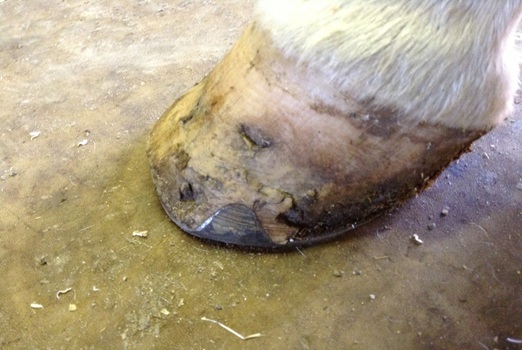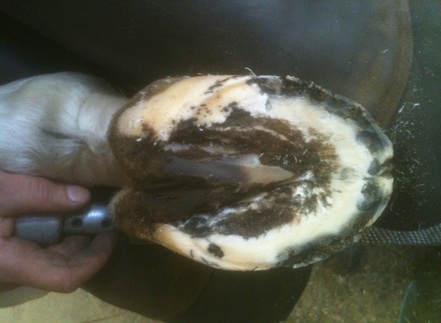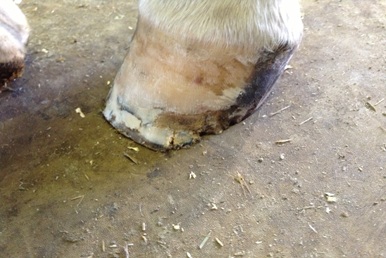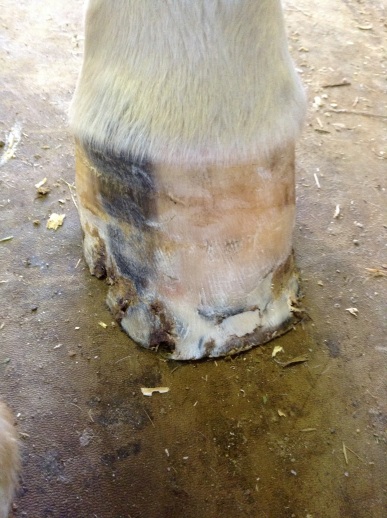I have horses that have chronic white lines disease and it typically gets worse during the summer months. The reason for this is the warm humid weather helps the fungi proliferate. These anaerobes are opportunistic, which means the anaerobes present themselves with the right causal factors: increased activity levels, moisture, heat, torque/concussion, and the right bio-chemistry.
I don’t want to be redundant. However, White lines disease and thrush have a lot of similarities. The Main difference between thrush and white lines disease is; the location of the infection(s). Also one is more fungal in orientation the other bacterial.
As I said in my article about thrush, you have to consider these causative factors, which create the infection. This bears repeating; horses get turned out in the same paddocks day in and day out, and after many years of manure, and urine being layered into the ground. You can see how paddocks become a breeding ground, for many opportunistic bacteria, and fungi.

Just as in the case for thrush there are some horses that are naturally resistant to white lines disease no matter how much they are exposed to it. With the converse also being true; there are horses that no matter how clean their environments are, or how well they are cared for, get infected.
Three contributing factors to white lines disease are; foot confirmation, biomechanical stress, and biochemistry. White lines disease has many similarities to thrush infections however to understand why white lines proliferates you have to delve into deeper into confirmation and how that affects biomechanical stress.
I mentioned the common causal factors previously but I want to dig deeper into the main opportunity, and difference, with thrush that causes these anaerobes to proliferate; which is torque.
White lines disease can also be called seedy toe. The reason for this name is that the infection attacks the toe region of the hoof capsule in between the outer horn and the sensitive tissues. This border between the outer wall and the sensitive tissues is called the laminae. Seedy toe is found in the laminae in the toe region of the hoof capsule. Which begs the question why? For us to answer the question, we have to delve into biomechanics and torque-specifically.
(I must add at this juncture that white lines disease also attacks the quarters and heels of the horses foot. The biomechanical stress that helps proliferation of the fungi is concussion.)
At the moment (physics term) of breakover torque causes the dorsal laminae to stretch. When this is done repeatedly the hoof capsule adapts(wolfs law) and grows longer. When you put these causal factors together: torque, biochemistry, humidity, anaerobes. The fungi start burrowing into the laminae from the solar(ground) surface of the hoof. The longer the toe is, the more torque is required to/at breakover. The more torque, the more stretching of the laminae creating greater opportunity for the fungi, giving you greater proliferation and infection.
If you have a white lines infection in the heels and quarters of the hoof, the things mentioned above apply, but! You substitute torque, for concussion.
Now what is the role of the farrier in all this?
The basics are:
- Trim and dress the foot to remove all the distortions of the hoof capsule.
- Balance the foot to help minimize torque and concussion.
- Create access for oxygen and medication to get to the infection site(s).
This was a horse I just recently acquired. He has the added difficulty of a thin wall making him susceptible to hot nails.

Note the divots from forging in front of the hoof capsule.
The pathogens (WLD) gained access to the hoof capsule from the divots and the sole.

The solar view of the infection.
Note the elongated /distorted hoof capsule and the stretched white line(now black).
Lack of horn integrity and torque has elongated the hoof capsule.

Because of the infection and the narrow hoof wall, nailing the shoe was not an option.

The circumstances led me to glue on a shoe so the horse could compete.

I was sent this picture after the horse pinned in the hunter pace.
